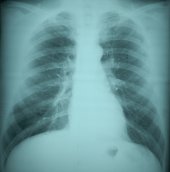Chest Radiography: Technical Practices

Radiographic Classification: Technical Practices
Radiographic classifications are a validated methodology for detecting and assessing certain occupationally-induced lung diseases. In this, the International Labour Office (ILO) International Classification of Radiographs of Pneumoconioses (ILO 2002) describes a systematic approach for obtaining standardized classifications. The usefulness of the approach has been demonstrated repeatedly. ILO classifications of radiographs have shown clear correlations with dust exposure, lung dust burden, lung pathology, mortality, and lung function (e.g., Attfield and Morring, 1992; Ruckley et al., 1984; Miller and Jacobsen, 1985; and Cotes and King, 1988).
The Need for Good Quality Radiographic Techniques and Equipment
It has long been recognized that both the technique and the equipment used for chest radiographic imaging of dust-exposed workers affect the ability to detect and assess abnormalities, and that this can impact the classification of the radiograph for disease. Consequently, it may be difficult or impossible to classify radiographs using the ILO system if the quality of the image is poor.
When obtaining radiographs for assessment using the ILO classification, development and adoption of a protocol giving clear quality control guidelines is necessary to avoid later problems in classification. For example, in the NIOSH there are strict requirements relating to the radiographic film, exposures, and equipment that must be used. Additionally, before radiographs may be submitted to NIOSH under the program, sample images from each radiographic unit must be evaluated and approved by NIOSH (42 CFR 37). Appendix A of the ILO document (ILO 2002) also provides technical guidance.
The Role of the NIOSH B Reader Program
In the United States, the B Reader Program has played a major role in advancing knowledge of radiographic classification using the ILO system. The B Reader certification examination, administered by NIOSH, is a rigorous evaluation of physicians’ capability to identify and appropriately classify radiographic appearances associated with dust-related disease.
Physicians who classify chest radiographs for certain federal surveillance programs may be required to be B Readers. For example, in the NIOSH Coal Workers’ X-ray Surveillance Program, physicians who classify radiographs for the program are required to be B Readers for the second and any later readings of each radiograph (42 CFR 37). The Asbestos Medical Surveillance Program, administered by the Navy and Marine Corps Public Health Center (NMCPHC), requires that the second reader of each radiograph be a B Reader. B Readers also have important roles to play in epidemiologic research, government programs, and contested proceedings.
References
Specifications for medical examinations of underground coal miners. 42 CFR 37
Attfield MD, Morring K. An investigation into the relationship between coal workers’ pneumoconiosis and dust exposure in U.S. coal miners. Am Ind Hyg Assoc J 1992; 53:486-92.
Ruckley VA , Fernie JM, Chapman JS, et al. Comparison of radiographic appearance with associated pathology and lung dust content in a group of coal workers. Br J Ind Med 1984; 41:459-67.
Miller BG, Jacobsen M. Dust exposure, pneumoconiosis, and mortality of coal miners. Br J Ind Med 1985; 42:723-33.
Cotes JE, King B. Relationship of lung function to radiographic reading (ILO) in patients with asbestos related lung disease. Thorax 1988; 43:777-83.
Asbestos Medical Surveillance Program. Navy and Marine Corps Public Health Center (NMCPHC).
